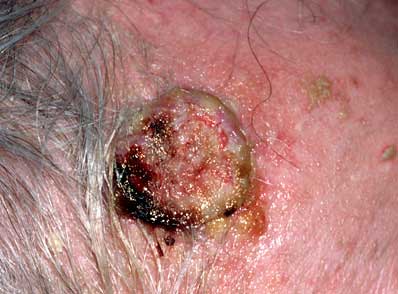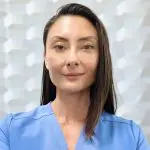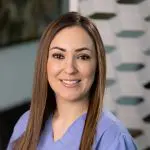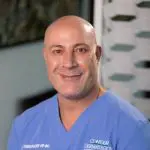Squamous Cell Carcinoma
Medical Dermatology - Skin Cancer
Squamous cell carcinoma is the second most common cancer of the skin. More than 250,000 new squamous cell carcinomas are diagnosed every year in the United States. Middle-aged and elderly people, especially those with fair complexions and frequent sun exposure, are most likely to be affected.
Squamous Cell Carcinoma
Medical Dermatology - Skin Cancer
Squamous cell carcinoma is the second most common cancer of the skin. More than 250,000 new squamous cell carcinomas are diagnosed every year in the United States. Middle-aged and elderly people, especially those with fair complexions and frequent sun exposure, are most likely to be affected.
This Skin Cancer Starts Out as Sandpaper Lesions
The cancer develops in the outer layer of the skin (the epithelium). Some squamous cell carcinomas arise from small sandpaper-like lesions called solar (sun) or actinic keratosis. It is possible for squamous cell carcinoma to spread to other areas of the body; therefore, early treatment is important. Although SCC is not often fatal, many of these lesions occur in the head and neck region, where surgery for advanced-stage disease can be disfiguring.
The classic presentation of a SCC is that of a shallow ulcer with heaped-up edges, often covered by a plaque, usually in a sun-exposed area. Typical surface changes may include the following:
-
Scaling
-
Ulceration
-
Crusting
-
A cutaneous horn
Squamous Cell Carcinoma (Skin Cancer) Treatment
- Excision: This is a surgical procedure that your dermatologist often can perform during an office visit. It involves numbing the area to be treated and cutting out any remaining tumor plus some normal-looking skin around the tumor.Like the skin biopsy, this removed skin is examined under the microscope. This may be done at a laboratory or by your dermatologist. The doctor who looks at the removed skin needs to see whether the normal-looking skin is free of cancer cells. If not, more skin will need to be removed. This is a common way to treat BCC.
- Curettage and electrodessication: This treatment consists of two steps. First, your dermatologist scrapes away the tumor. Then electricity is used to destroy any remaining cancer cells. The two steps are then repeated.
- Mohs surgery: Named for the doctor who developed this surgery, Mohs (pronounced “moes”) is a specialized surgery used to remove some skin cancers. It offers the highest cure rate for difficult-to-treat basal cell cancers. Dr. Jochen is an expert in Mohs surgery and can tell you if Mohs is right for you.
If Mohs is recommended, this is what you can expect. The surgeon will cut out the tumor plus a very small amount of normal-looking skin surrounding the tumor. While the patient waits, the Mohs surgeon uses a microscope to look at what was removed. The surgeon is looking for cancer cells. If necessary, during the Mohs surgery, the surgeon will continue to remove a very small amount of skin and look at it under the microscope. This continues until the surgeon no longer sees cancer cells. - Cryosurgery: This treatment uses liquid nitrogen to freeze cancer cells, causing the cells to die.
- Radiation: This treatment usually is reserved for BCCs that cannot be cut out, or when surgery may not be the best choice. A patient may need 15 to 30 radiation treatments.
- Photodynamic therapy (PDT): This treatment uses light to remove early skin cancers. PDT is a two-step process. First, a chemical is applied to the skin. The chemical remains on the skin for some time so that it can be absorbed. Then the skin is exposed to a special light to kill the cancer cells.
- Medicated creams: Creams that contain a drug, such as imiquimod or 5-fluorouracil, can be used to treat early BCC. Use as directed by our dermatologist.
- Pills: While extremely rare, there are reports of BCC spreading to other parts of the body. Patients who have BCC that spreads may be prescribed vismodegib. This medication also may be prescribed for patients who have advanced BCC that cannot be cut out or treated with radiation.
- IGSRT: Image-Guided Superficial Radiotherapy (IGSRT) as a non-surgical option for treating basal cell carcinoma (BCC). IGSRT utilizes low levels of X-ray energy to precisely target and eliminate cancer cells while preserving surrounding healthy tissue. This method is particularly beneficial for patients seeking a non-invasive alternative to surgery. Studies have demonstrated that IGSRT achieves high rates of tumor control, making it an effective option for treating non-melanoma skin cancers.

















